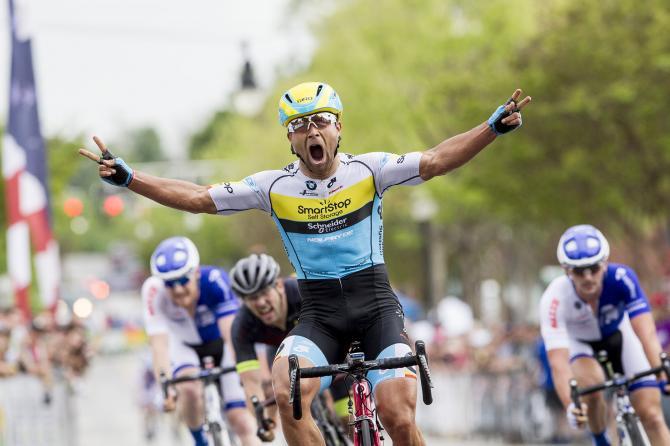Creating, Establishing and Committing to a Breakaway

Eric Marcotte wins out of a breakaway. Photo Credit: Casey Gibson
Welcome to the mid-season for road racing, 2016. All around the country, Source Endurance athletes have been taking chances and getting up the road only to have the breakaway attempt fail for a multitude of reasons. I thought I’d take a couple minutes and send out this easy user’s guide to establishing a breakaway.
Everyone hears it, “MOVE UP!” It’s the one piece of advice that spectators, parents, coaches and teammates give that is (mostly) always useful. Move up. However, very little is ever mentioned about exactly what should be done once you are actually moved up. Most riders do one of two things: they attack immediately or they succumb to the swarm and get buried again only to hear those two syllables and begin the process anew.
In order to be in the break in any race, it is imperative that you develop the fitness and skill necessary to stay in the front and be rested for one of the race defining moments. In looking at our elite athletes’ data from high level races, we find that a couple of conditions need to be met before your breakaway can work.
First, you should be in the front but not on the front. Data from breakaways in the high level races, especially an

Joseph Schmalz in the breakaway, 2010 Tulsa Tough. Photo Credit: Lyne Lamoureux.
NCC criterium, show us that you must be positioned and rested when it’s time to make your move.
Be patient. You only have so many major efforts on any given day so be sure you save your effort for the “right time.” I could write an entire book on when the “time is right” and, someday, I may do just that.
Be prepared. The opening effort of a breakaway is a truly difficult thing. Once you commit to the move, get ready for one of the hardest five minute efforts of your life. You must establish the move with a sizeable gap so that it is not bridgeable by any one person from the peloton. This must be done quickly, before the peloton reshuffles and gathers their composure.
So what kind of “hardest five minute effort” are we talking about? When Joe Schmalz escaped the peloton on Friday at Tulsa Tough in 2010, he clocked 5 minutes at 401W normalized. Eric Marcotte posted 453W normalized for the first 5 minutes of his Saturday breakaway at Tulsa Tough in 2013 and David Santos ripped 425W for the first 5 minutes establishing his move at the 2015 Dana Point GP.
Equally important is that the next person contributes. Many a promising move has been smothered because the next person either will not or cannot commit to riding in the move. No success in bike racing is easy and this sort of effort only reinforces that notion. Just remember, five minutes. It will only be absolutely ridiculous for five minutes before it settles down. But, in that five minutes, everyone must be all in.

David Santos in the breakaway at the 2015 NCC Dana Point GP. Photo Credit: Danny Munson
“Settle in.” I put this in quotes because “settle” implies relaxing but now that you’ve escaped, only one thing matters – speed. At worst you need to maintain your speed equal to the peloton. At best, you’re putting 1-2 seconds on the peloton per lap. When you get to this point, listen to the announcer. Any announcer worth his salt will be calling the time gaps consistently for both the peloton and escapees.
Looking back to the 2015 Manhattan Beach GP, during the “next 20 minutes”, David Santos and Co. set a blistering pace of 27.9mph while David was producing around 350W normalized. Meanwhile the peloton consistently forfeited valuable time, only mustering 27.2 mph and 270W norm if you were fortunate enough to not be contributing to the chase.
Once you and your fellow escapees can get to this point, it is crucial to keep cooperating. Being in a breakaway and making it to the finish line in that breakaway are completely different accomplishments. While the break is capable of riding faster than the peloton under the right circumstances, it is also capable of quickly squandering that lead. Remember that the peloton will continue at a more or less consistent speed and that must be considered in all of your tactical decisions.
Now that you know a little about establishing a breakaway, go out and try it this weekend. But remember – if it was easy, then everyone would be in the break… and that would make it the peloton.
 About Adam Mills: Adam’s true talent comes with his ability to combine his vast experience with his knowledge of sport. He is indeed a student of science, sport, athletic performance, strategy, and tactics. He continuously educates himself by keeping up to date with current trends and methods in sport. Adam is able to incorporate these attributes to help his clients reach and exceed their goals whether they are a beginner or a seasoned professional. Learn more about Adam and Source Endurance here.
About Adam Mills: Adam’s true talent comes with his ability to combine his vast experience with his knowledge of sport. He is indeed a student of science, sport, athletic performance, strategy, and tactics. He continuously educates himself by keeping up to date with current trends and methods in sport. Adam is able to incorporate these attributes to help his clients reach and exceed their goals whether they are a beginner or a seasoned professional. Learn more about Adam and Source Endurance here.
[…] Creating, Establishing, and Committing to a Breakaway […]